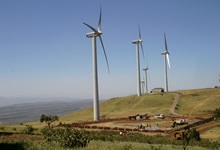

Wind energy development booming in Kenya
Posted on : Tuesday, 2nd September 2014

Kenya's wind energy capacity is considerable; the United Nations Environment Programme (UNEP) has estimated it could reach 3,000 Megawatts (MW), more than double the current national demand. Northern districts like Turkana and Marsabit have the greatest potential, and wind farm construction here is proceeding apace. A Dutch consortium, the Lake Turkana Wind Power Company (LTWC) has leased 70,000 hectares for construction of a 380 turbine wind farm, one of the largest in the world. When completed, the Lake Turkana wind farm is estimated to generate over 20 per cent of national electricity supply, and be the cheapest source of electricity in the country. A 300 mile transmission line will connect the wind farm to the national grid.
Other projects approved by the Ministry of Energy include a 300MW project in Marsabit in Kenya's Upper Eastern province, 350MW from various sites in Lamu Coast province and a 60MW facility in Kinangop, north of Nairobi. All these are due to be in operation by the end of 2013 or sooner, with the Government planning to offer US$8 billion in incentives for private sector investment. Patrick Nyoike, Permanent Secretary at the Ministry of Energy, is passionate about the need for that investment. "We realize that power rationing and prohibitive electricity charges only end up doing more harm than good to our economy and our people," he says. "This has inspired us to look into alternatives, chief among them wind. We have to get everyone on board to light every corner of the country and get our people out from the darkness."
Key to these ambitions is the Scaling-Up Renewable Energy Program in Low Income Countries (SREP), which operates through the Climate Investment Fund, with financial support from bilateral partners, notably the UK Department for International Development and the Government of The Netherlands. International carbon trading markets are also set to provide considerable funding; the Lake Turkana wind farm is estimated to be eligible for over €7 million in carbon credit payments, once completed.
While the government is supporting construction of mega projects, thousands of individual Kenyans are also choosing to invest in wind power. Surveys by market research company Synnovate have shown a 30 per cent increase in the number of companies selling renewable energy devices over the last five years. Norman Chege, Solar Division Manager at equipment firm Davis and Shirtliff, can attest to the growing popularity; in the same period, sales of household wind turbines by his company have tripled.
Customers have been attracted by the potential to generate their own power and avoid spiralling bills, as well as by the small amount of space needed to install a turbine. "It means I still have space for growing more in my garden and for anything else I want to set up. Space is everything around here," says Lincoln Omondi, a 35 year old bank teller who lives in Isinya, a semi arid area to the south of Nairobi. His 1,000 Watt generator, bought for around US$1,500, provides enough power to light his home, operate his appliances, power a small pump in his house and produce a surplus he can store in a battery.
In Isinya, Omondi is not alone in his enthusiasm for wind turbines. The area is exposed to consistently strong winds, but is far from the national grid, and these combined factors have led to a massive uptake in household generating devices. According to Davis and Shirtliff, 45 per cent of households in the area rely on wind energy for one or more activities, whether for farming or household needs. "That is a huge number, which has baffled us," says Norman Chege. "But it has also allowed us to spread the message of wind energy adoption at household level to other areas that have strong winds, using Isinya as a success story. Already in areas like Kajiado the response is promising," he says.
Recently, the government's Rural Electrification Authority (REA), in partnership with Japan International Cooperation Agency (JICA), has embarked on a pilot project to promote wind turbines among communities, institutions and individuals. The project is installing wind turbines for domestic electricity supply, with the surplus being sold to the Kenya electricity generating company Kengen. "It is a very promising and ambitious project," says Nathan Kabue a senior engineer at the REA, "One we anticipate will spur installation of more windmills and other renewable sources of energy like solar, so that we can reduce the over reliance on hydro power as we accelerate electricity connectivity across the country."





























































